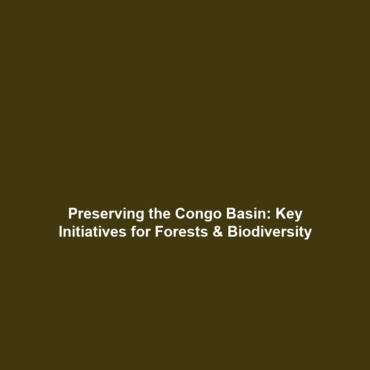Initiatives Aimed at Preserving the Congo Basin’s Forests and Biodiversity
The Congo Basin, a vital ecological zone, harbors some of the world’s most diverse ecosystems. Initiatives aimed at preserving the Congo Basin’s forests and biodiversity are not only essential for maintaining their intrinsic value but also for mitigating the global impacts of deforestation and biodiversity loss. This article delves into significant initiatives, emphasizing their critical role in safeguarding the ecological balance in this unique region.
Key Concepts
Understanding the context of the Congo Basin within the broader theme of deforestation and biodiversity loss involves several vital concepts:
- Deforestation: The clearing of forested areas, primarily for agriculture, logging, and development.
- Biodiversity Loss: The decline in the variety of life across all levels, which threatens ecosystem stability.
- Conservation Initiatives: Programs and policies aimed at protecting forested areas and promoting sustainable practices.
- Sustainable Development: Balancing ecological preservation with community and economic benefits.
These concepts interrelate, emphasizing the need for innovative strategies that combine conservation and sustainable development to effectively combat deforestation and biodiversity loss.
Applications and Real-World Uses
Initiatives aimed at preserving the Congo Basin’s forests can have significant real-world applications:
- Agroforestry Projects: Integrating trees and shrubs into agricultural land enhances biodiversity and provides alternative income sources for local communities.
- Community-Based Conservation: Empowering local communities to manage and protect forest resources mitigates deforestation and promotes biodiversity.
- Ecotourism Initiatives: These programs not only provide financial support for conservation but also educate the public regarding the importance of the ecosystem.
Through these applications, the initiatives showcase how effective strategies can simultaneously address deforestation and biodiversity loss.
Current Challenges
While there are many initiatives aimed at preserving the Congo Basin’s forests, several challenges hinder their effectiveness:
- Political Instability: Ongoing conflicts and governance issues can disrupt conservation efforts.
- Lack of Funding: Insufficient financial resources often limit the scope of existing initiatives.
- Climate Change: Ongoing climate shifts pose additional stress on the ecosystems threatened by deforestation and biodiversity loss.
Addressing these challenges is integral to the success of any initiatives aimed at conservation.
Future Research and Innovations
Innovations in research play a crucial role in advancing initiatives aimed at preserving the Congo Basin’s forests and biodiversity:
- Remote Sensing Technology: Enhanced satellite imagery allows for better monitoring of deforestation rates and biodiversity.
- Genetic Studies: Increased understanding of species resilience can inform conservation strategies.
- Blockchain for Transparency: Utilizing blockchain technology can enhance transparency and accountability in resource management.
Continued research and technological advancements are essential for the future of preserving the Congo Basin amidst the challenges of deforestation and biodiversity loss.
Conclusion
Initiatives aimed at preserving the Congo Basin’s forests and biodiversity are critical not only for the local environment but also for global ecological health. Addressing deforestation and biodiversity loss through sustainable practices is imperative for our future. As we move forward, it is essential to support these initiatives, prioritize conservation efforts, and engage in further research to develop innovative solutions. For more information on conservation strategies and the importance of biodiversity, please visit our related articles.

Leave a Reply